Minister of National Defense Han Min-goo Founded 15 August 1948 Minister of defense Han Min-goo | Budget 38.84 trillion KRW (2016) | |
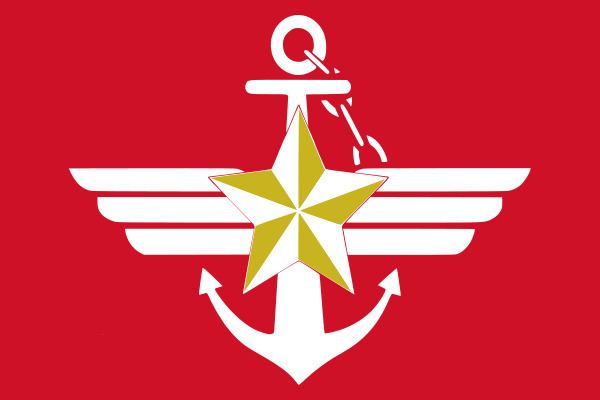 | ||
Commander-in-Chief Hwang Kyo-ahnPresident of South Korea Chairman of the Joint Chiefs of Staff General Lee Soon-Jin, ROKA Military age Voluntary from 18, mandatory 20 to 38 years of age for male, wartime conscription 18–40 years of age Conscription 21–24 months depending on the branch Similar Republic of Korea Army, Republic of Korea Navy, Republic of Korea Air Force, Korean People's Army, Republic of Korea Marine C | ||
The Republic of Korea Armed Forces (Korean: 대한민국 국군; Hanja: 大韓民國國軍; Revised Romanization: Daehanminguk Gukgun, literally "Great Korean Republic National Military") are also known as the ROK Armed Forces, are the armed forces of South Korea. Created in 1948, following the division of Korea, the Republic of Korea Armed Forces is one of the largest standing armed forces in the world with a reported personnel strength of 3,725,000 in 2016 (625,000 active and 3,100,000 reserve). The ROK military forces are responsible for maintaining the sovereignty and territorial integrity of the republic, but often engage in humanitarian and disaster-relief efforts nationwide. More recently the ROK military began increasing its participation in international affairs, acknowledging its role and responsibility as the eleventh economic power in the world in terms of GDP. The ROK military has participated in various peacekeeping operations, and counter-terrorism operations.
Contents
- Republic of korea armed forces 2015 2015
- History
- Structure
- National Command Authority
- Joint Chiefs of Staff
- ROK Army
- ROK Navy
- ROK Marine Corps
- ROK Air Force
- Personnel
- Ranks
- Oath
- Honors
- Modernization and future
- References
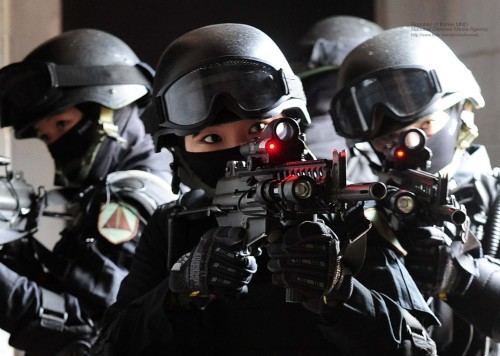
Republic of korea armed forces 2015 2015
History
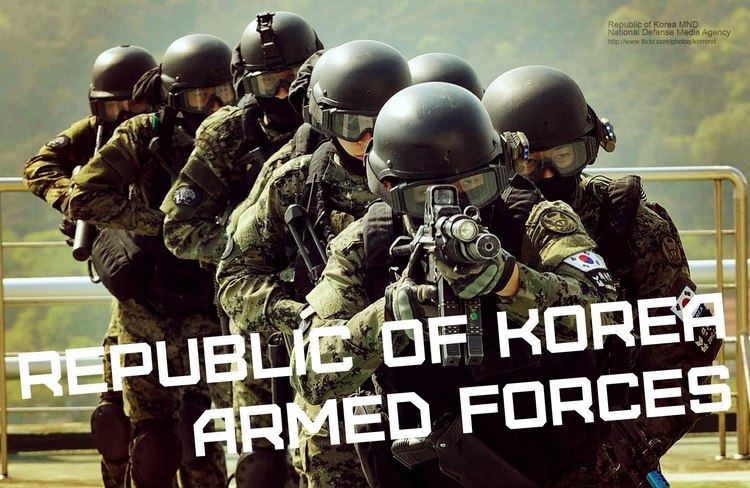
The South Korean armed forces were largely constabulary forces until the outbreak of the Korean War. It was heavily damaged by North Korean and Chinese attacks and in the beginning relied almost entirely on American support for weapons, ammunition and technology. After the Korean War South Korea maintained a large military ground force, which in 1967 had about about 535,000 personnel, much larger than the northern forces of about 345,000. During South Korea's period of rapid growth in the 1980s, the military modernised, benefiting from several government-sponsored technology transfer projects and indigenous defense capability initiatives. The GlobalSecurity.org website states that "in 1990 South Korean industries provided about 70 percent of the weapons, ammunition, communications and other types of equipment, vehicles, clothing, and other supplies needed by the military."
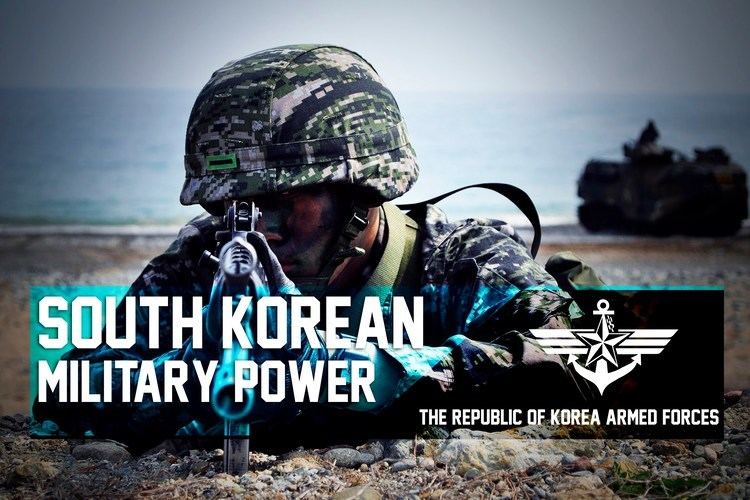
Today, the South Korean armed forces enjoy a good mix of avant-garde as well as older conventional weapons. South Korea has one of the highest defense budgets in the world, ranking 12th globally in 2011, with a budget of more than $30 billion U.S. dollars. Its capabilities include many sophisticated American and European weapon systems, complemented by a growing and increasingly more advanced indigenous defense manufacturing sector. For example, by taking advantage of the strong local shipbuilding industry, the ROK Navy has embarked on a rigorous modernization plan with ambitions to become a blue-water navy by 2020. South Korea has a joint military partnership with the United States, termed the ROK-U.S. Alliance, as outlined by the Mutual Defense Treaty signed after the Korean War. During the outbreak of the Vietnam War, ROK Army and the ROK Marines were among those fighting alongside South Vietnam and the United States. More recently, South Korea also takes part in regional as well as pan-Pacific national military wargames and exercises such as RIMPAC and RSOI. Among other components of the armed forces is the Defence Security Command, originally the Army Counter-Intelligence Corps, which had a major role in monitoring the military's loyalty during the period of military rule in South Korea.
Until January 2011, "mixed-race" men were prohibited from being conscripted into the South Korean military.
Structure
The ROK Armed Forces consists of the:
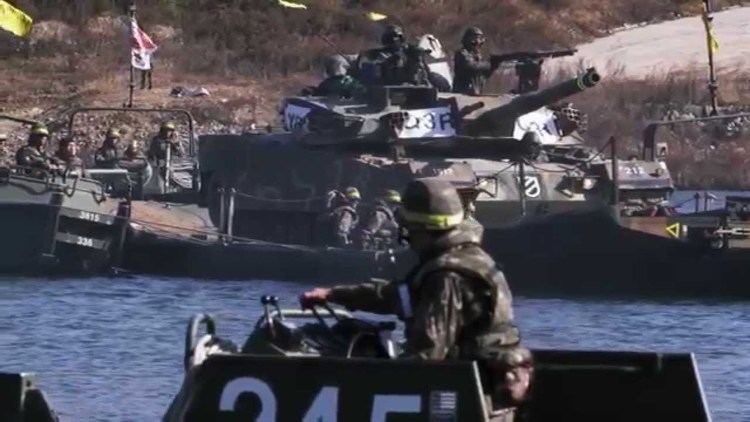
In addition, reserve elements consist of the:

National Command Authority
The President is the Commander-in-Chief of the Armed Forces ex officio. The military authority runs from the President to the Minister of Defense, who is commonly (but not legally bound to be) a retired 4-star General (equivalent to a British Army/Commonwealth full General or a Royal Navy/Commonwealth Admiral).
The Chairman of the Joint Chiefs of Staff, a 4-star General or Admiral, is the Senior Officer of the Armed Forces and has the Operational Authority over the Armed Forces, with directions from the President through the Minister of Defense. Traditionally (with one exception), the position is filled by an officer of the Army. The chain of Operational Authority runs straight from the Chairman of the Joint Chiefs of Staff to the Commandants of the several Operational Commands. Currently there are five Operational Commands in the Army, two in the Navy (including the Marine Corps) and one in the Air Force.
The respective Chiefs of Staff of each Service Branch (Army, Navy, Air Force) has administrative control over his or her own service. Each Chief of Staff is also a standing member of the Joint Chiefs of Staff.
Joint Chiefs of Staff
The Republic of Korea Joint Chiefs of Staff headquarters (Hangul: 대한민국 합동참모본부, Hanja: 大韓民國 合同參謀本部) is a group of Chiefs from each major branch of the armed services in the Republic of Korea Armed Forces. Unlike the United States, the Chairman of the Joint Chiefs of Staff has operational control over all military personnel of the armed forces.
All regular members are 4-star generals or admirals, although the deputy chairman sometimes has only 3 stars.
ROK Army (대한민국 육군)
The ROK Army (ROKA) is by far the largest of the military branches, with 495,000 personnel as of 2014. This comes as a response to both the mountainous terrain native to the Korean Peninsula (70% mountainous) as well as the heavy North Korean presence, with its 1-million-strong army, two-thirds of which is permanently garrisoned in the frontline near the DMZ. The current administration has initiated a program of self-defense, whereby South Korea would be able to fully counter the North Korean threat with purely domestic means within the next two decades.
The ROK Army was formerly organized into three armies: the First Army (FROKA), Third Army (TROKA) and Second Operational Command each with its own headquarters, corps (not Second Operational Command), and divisions. The Third Army was responsible for the defense of the capital as well as the western section of the DMZ. The First Army was responsible for the defense of the eastern section of the DMZ whereas the Second Operational Command formed the rearguard.
Under a restructuring plan aimed at reducing redundancy, the First and Third Armies will be incorporated into the newly formed First Operations Command, whereas the Second ROK Army has been converted into the Second Operational Command. The army consists of the Army Headquarters, the Aviation Command, and the Special Warfare Command, with 7 corps, 39 divisions, some 520,000 troops and estimated as many as 5,850 tanks and armored vehicles, 11,337 artillery systems, 7,032 missile defense systems and 13,000 infantry support systems.
The army will take the brunt of the personnel reduction part of the Defense Reform 307. Associated with this personnel reduction would be a significant reduction in the ROK Army force structure, in particular decreasing the current force of 47 divisions (active duty and reserve) down to a force of about 28 divisions.
ROK Navy (대한민국 해군)
The ROK Navy (ROKN) is the armed forces branch responsible for conducting naval operations and amphibious landing operations. As a part of its mission, the ROK Navy has engaged in several peacekeeping operations since the turn of the century. The ROK Navy includes the Republic of Korea Navy Headquarters, Republic of Korea Fleet, Naval Logistics Command, Naval Education and Training Command, Naval Academy, and Republic of Korea Marine Corps, which is a quasi-autonomous organization. The Chief of Naval Operations (CNO) is the highest-ranking officer (four-star admiral) of the ROK Navy.
In 1995, Admiral An Pyongtae, the 20th Chief of Naval Operations, presented the vision of building a "blue ocean navy" for the future of the ROK Navy in his inaugural address. In 2001, then President Kim Dae-jung announced a plan for building up a Strategic Mobile Fleet. As a part of "Defense Reform 2020," which was proposed by the Roh Moo-hyun Administration, the ROK Navy is required to reform the organizations under Commander-in-Chief Republic of Korea Fleet (CINCROKFLT) by upgrading a submarine operations command (to fleet submarine force), a naval aviation operations command (to fleet air arm), and by establishing some Mobile Flotillas. The ROK Navy aims to become a blue-water navy by 2020.
In the first decade of the 21st century, the ROK Navy launched the lead ships of newly developed types: in 2002, ROKS Chungmugong Yi Sunshin (DDH 975), a 4,500-ton destroyer, was launched; in 2005, the 14,000-ton amphibious landing ship, ROKS Dokdo (LPH 6111) was launched; in 2006, the ROK Navy launched the Sohn Won-yil (SS 072), an 1,800-ton Type 214 submarine with Air-Independent propulsion (AIP) system. In 2007, the ROK Navy launched the lead ship (DDG 991) of the King Sejong the Great class destroyer, built around the Aegis combat system and the SPY-1D multi-function phased array radar. The ROK Navy is undertaking several shipbuilding projects: Korean Destroyer Experimental (KDX) program, Frigate Experimental (FFX), Landing Platform Experimental (LPX), Patrol Killer Experimental (PKX), and Korean Submarine (KSS) program.
The ROK Navy hosted its second international fleet review off the coast of Busan in October 2008.
ROK Marine Corps (대한민국 해병대)
Although the National Armed Forces Organisation Act stipulates that the ROK Navy includes the Republic of Korea Marine Corps, the ROKMC is a semi-autonomous organization that carries out much of its functions independently. During the Korean War, the ROKMC earned their nickname as "귀신잡는 해병대" (English: Ghost-Catching Marines).
The motto of the ROK Marine Corps is "한번 해병은 영원한 해병" (Once a Marine, Forever a Marine).
ROK Air Force (대한민국 공군)
The ROK Air Force (ROKAF) maintains a modern air force in order to defend itself from various modes of threats, including the North Korean Army. The ROK Air Force fields some 450 combat aircraft of American design. In contrast, the North Korean Army has roughly 650 combat aircraft, but mostly obsolete types of Soviet and Chinese origin.
Korea began a program for the development of indigenous jet trainers beginning in 1997. This project eventually culminated in the KAI T-50, dubbed the "Golden Eagle" which is used as a trainer for jet pilots, now being exported to Indonesia. A multirole all-weather version of the T-50 is the modified FA-50, which can be externally fitted with Rafael's Sky Shield or LIG Nex1's ALQ-200K ECM pods, Sniper or LITENING targeting pods, and Condor 2 reconnaissance pods to further improve the fighter's electronic warfare, reconnaissance, and targeting capabilities. Other improved weapon systems over FA-50 include SPICE multifunctional guidance kits, Textron CBU-97/105 Sensor Fuzed Weapon with WCMD tail kits, JDAM, and JDAM-ER for more comprehensive air-to-ground operations, and AIM-120 missiles for BVR air-to-air operations. FA-50 has provisions for, but does not yet integrate, Python and Derby missiles, also produced by Rafael, and other anti-ship missiles, stand-off weapons, and sensors to be domestically developed by Korea.
The Republic of Korea Air Force also expressed interests in acquiring the RQ-4 Global Hawk and Joint Direct Attack Munition kits to further improve their intelligence and offensive capabilities.
The replacement programs for the F-4D/E and F-5A/B/E/F are the KTX-2 and F-X, respectively. The latter has been fulfilled by the Boeing F-15K.
The South Korean government also announced its plan to develop indigenous helicopter manufacturing capacities to replace the aging UH-1 helicopters, many of which had seen service during the Vietnam War. The program originally included plans for the development of both a civilian and a military helicopter. This was later revised and gave priority to the utility helicopter program. Based on the success and experience of the civilian KMH (Korean Multi-purpose Helicopter) the attack helicopter, which would share a common configuration, will be developed.
Personnel
Military service is mentioned as one of the Four Constitutional Duties (along with taxes, education, and labor) for all citizens. The current effective Conscription Law, however, applies only to males although women can volunteer as officers or non-commissioned officers. Military service varies according to branch: 21 months for the Army and Marine Corps, 23 months for the Navy, 24 months for the Air Force and civil service. The other professional civil service is from 26 months to 36 months. Korea has a bonus point system (Hangul: 군가산점; Hanja: 軍加算點; RR: gungasanjeom) which gives a person who completed military service bonus points when applying for a job.
Recently, however, there has been significant pressure from the public demanding either a shortening of the term or a switch to voluntary military service.
In the Republic of Korea Armed Forces, ranks fall into one of four categories: commissioned officer, warrant officer, non-commissioned officer, and enlisted, in decreasing order of authority. Commissioned officer ranks are further subdivided into "Janggwan" or general officers, "Yeonggwan" or field grade officers, and "Wigwan" or company officers. The "Wonsu" is appointed from the "Daejang" who has distinguished achievements. However, there has been no one holding the rank of "Wonsu" in the history of the ROK Armed Forces. All branches share a common rank-system, with different colors used to denote the different branches (Army: Green & Black, Navy: White & Black, Marine Corps: Red & Yellow, Air Force: Green & Blue).
Ranks
Note: The English titles are given as comparative examples with the US Army ranks.
Oath
Until April 2011, South Korean soldiers swore allegiance to the "Korean race" in their oaths of enlistment. Likewise, until 2007, the South Korean civilian pledge of allegiance was also to the "Korean race".
Honors
In 2008, officers and soldiers of Unit Dongmyeong, stationed in Lebanon with the UNIFIL, received honorary medals from the United Nations.
Modernization and future
The ROK military forces are undergoing rapid modernization in preparation for assuming wartime operational control of the ROK's defenses by December 2015. Several cutting-edge military systems are currently being inducted. At the same time, the ROK Armed Forces will see a reduction in active duty personnel from 640,000 to 517,000 by the end of this decade.
